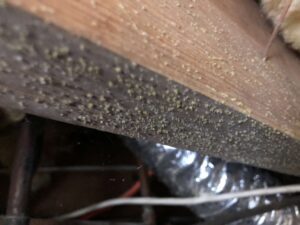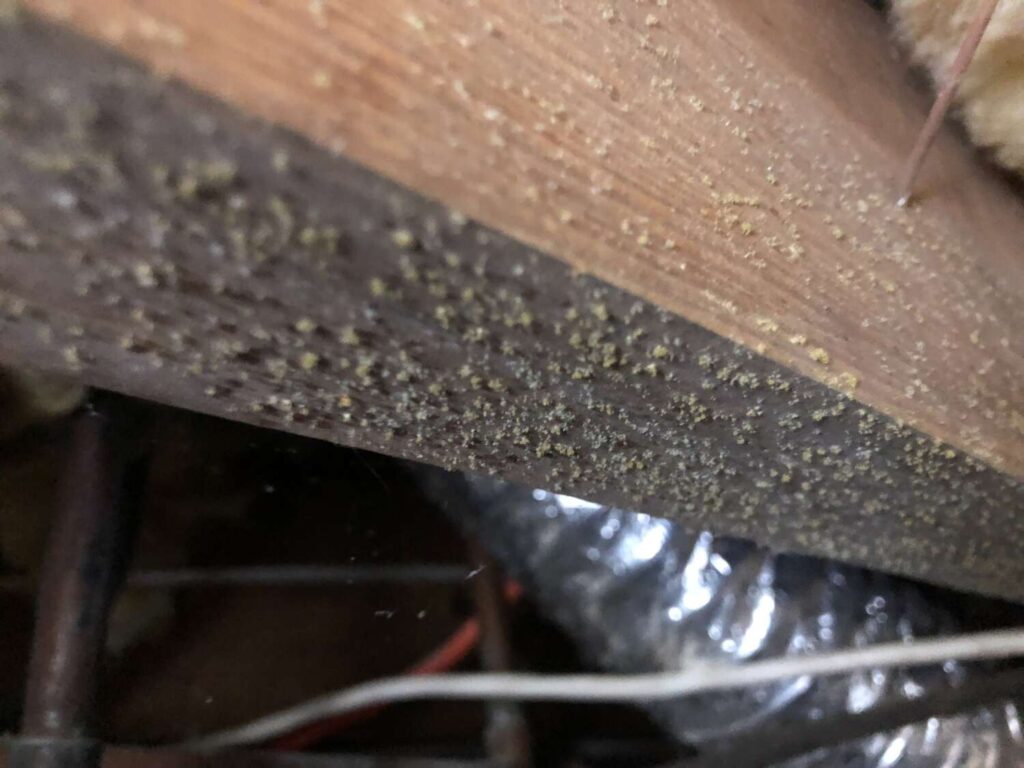Here in Western North Carolina, we have a perfect storm of interrelated environmental factors which often lead to excess moisture and mold growth in houses of all ages and design.
As an equal-opportunity fungal parasite, mold doesn’t care when the house was built or whether it is “green.” As long as there is sufficient moisture and organic material to feast on, such as wood and drywall, plan on hosting mold at the banquet!
The good news is that indoor mold problems can be prevented or managed with a greater awareness of conditions of concern and a plan to identify and address moisture issues as they arise. This article will help you towards that goal.
Why it’s pervasive
In addition to the many natural blessings the mountain region offers, it also poses challenges to the goal of staying dry, which is the critical requirement for preventing indoor mold growth.
- Climate: With annual rainfall totals of up to 100 inches and relative humidity hitting the dew point most summer nights, fungal diversity and proliferation are here to stay. In addition, the cooler mountain temperatures lessen demand for air conditioning during the humid summer months when it is needed to control humidity.
- Topography: Most mountain lots slope to one or more sides of the house which creates the need for properly designed, constructed, and maintained systems to effectively divert stormwater runoff away from the foundation.
- Geology: Compounding the rain and runoff conditions, the heavy clay subsoils don’t drain but rather swell and hold moisture.
- Hydrogeology: Intermittent springs and seeps are common in the mountains. Sometimes such features aren’t discovered until after the house is built!
- Dendrology: Dense and mature trees and shrubs contribute to both moisture retention around houses as well as shading which results in cooler homes with reduced need for moisture-reducing air conditioning. In addition, leaf litter clogs drainage systems, such as gutters, while serving up an annual supply of groceries to our fungal friends and neighbors. Also, beware the dendro-root systems which can compromise below-grade foundation walls and contribute to basement moisture infiltration.

How it happens
We can categorize housing mold problems in terms of existing construction and under construction, each with their own set of moisture concerns.
Houses under construction face unique temporary challenges associated with exposure to wet weather and construction delays and sequencing issues. For example, a house must be “dried-in” before the heating, ventilation, and air conditioning systems are installed and activated. Uncontrolled moisture in the interim puts framing lumber and finish materials at risk of mold growth. The consequences can present major setbacks to the budget and schedule.
Awareness of these and related conditions allows the contractor to implement appropriate monitoring, prevention, and response measures, such as: real-time humidity and material moisture monitoring; temporary installation of dehumidifiers and other mechanical controls as needed to quickly dry materials and prevent mold growth; and mold remediation as needed.
Mold growth in existing construction usually falls within one of several categories specific to the structure.
- Water leaks (i.e., plumbing, roof, foundation, flashing)
- Outdated and inadequate construction methods (i.e., waterproofing of foundation walls in below-grade basements and crawl spaces)
- Deferred maintenance (i.e., clogged gutters)
- Plumbing leaks (i.e, freeze damage, clogging, corrosion)
- Lack of awareness (i.e., unattended vacation home, investment property, people comfortable in a tropical indoor environment)
Contrary to popular belief, older homes are not inherently more mold-prone than new construction. In fact, some materials commonly found in older homes (e.g., plaster) are more mold-resistant than modern alternatives (e.g., drywall).
In addition, older growth lumber is denser and less prone to mold growth than new lumber. Older construction “breathes” more than the tight and energy-efficient, modern home. That’s why it is important to incorporate appropriate ancillary ventilation and humidity control systems into the green-built design, such as energy recovery ventilators.
On the other hand, older construction has had more time for moisture issues to develop due to age-related conditions such as material and component degradation and deferred maintenance.
Regardless of whether the house is existing or under construction, mold prevention and control starts with moisture monitoring. By keeping tabs on moisture conditions, a problem can be identified before it escalates to the point of causing mold growth and resultant unhealthy impacts to indoor air quality.
The two basic tools of the trade are a meter for measuring material moisture levels and a hygrometer for humidity monitoring. The data provided by such tools is useful under many scenarios, such as ensuring that framing lumber and concrete slabs are sufficiently dry before installing flooring or wall coverings or monitoring indoor humidity levels to warn against high moisture conditions before mold growth starts.
When to seek help
Despite best efforts and intentions, stakeholders often find themselves in need of professional mold and moisture services to evaluate sources and identify effective corrective measures.
When seeking help, it’s important to understand that mold inspections are not created equally. North Carolina does not regulate the industry, and there are no licensing, experience, or educational requirements as there are for engineers and home inspectors, for example.
An unlicensed service provider has nothing to lose, no skin in the game, and no one to hold them accountable. This places the onus on the client to assess qualifications before hiring, with questions such as:
- Do you have a relevant professional state license?
- What is your education and experience background?
- Do you have an annual continuing education requirement?
- Do you have excellent reviews and references?
- Do you provide a custom, professionally written and reviewed report including data interpretation, conclusions, and recommendations?
Once you’ve found your environmental consultant and entered under contract, a mold and moisture inspection with testing is typically the next step.
The type and number of samples appropriate for any given situation is dependent upon the client’s concerns, purpose, and scope. Inspection and testing fees will range accordingly.
Air samples to evaluate breathing zone mold spore concentrations are always informative because that is the primary exposure pathway. In addition, site-specific conditions and client objectives should be considered in the mold sampling design. For example, high material moisture levels in a below-grade wall would indicate the need for wall cavity air samples to evaluate potential hidden mold growth.
If inspection and testing reveal significant impacts to indoor air quality from mold growth, it is important to eliminate the sources of mold and the moisture conditions that caused them. As a rule, mold remediation should be performed under containment and negative air pressure by trained personnel to prevent dispersal of mold spores to other areas of the house.
If you proceed as a do-it-yourself project on minor mold issues, be sure to follow industry standards and guidance to ensure appropriate personal protection and cleanup methods are used.
Upon completion of remediation, clearance inspection and testing is recommended to be performed by an independent third-party indoor environmental professional (IEP). By comparing pre-remediation mold concentrations to post-remediation, insight is gained into the effectiveness of remediation efforts.
Hopefully, you will end up with only normal background mold concentrations in the air, no remaining visible mold growth, and no ongoing elevated moisture conditions.
Whether you are a builder or homeowner, the old adage “an ounce of prevention is worth a pound of cure” is one that is particularly applicable to mold in Western North Carolina.
John Mueller is president of local, family-owned and operated, Mueller Environmental and Home inspection Inc., serving Western North Carolina since 2003. As a North Carolina-licensed engineer and home inspector with 35 years of experience, Mueller offers consulting services aimed at characterizing and solving client concerns at homes and businesses. Connect with John at muellerhomeenvironment.com.
You can also view this article as it was originally published on page 66 of the 2022-23 edition of the directory.


